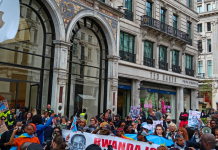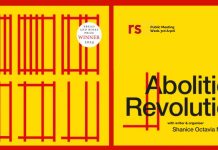For the past year a growing refugee crisis on Europe’s borders has allowed the political right to capitalise on xenophobic and paranoid fears spread by racist politicians and media. Even those who have rejected the more outrageous expressions have often accepted the classification of those seeking resettlement along the lines of the ‘deserving’ refugees and asylum seekers and the ‘less deserving’ ‘economic’ migrants and ‘benefit seekers’ who the press demonise as a threat to jobs and welfare resources.
Over the next three days, Brian Parkin will argue that the rise in the numbers of those desperate to seek refuge is just the beginning as the unconstrained consequences of imperialist conflict and climate change combine to displace whole populations amid the conditions of a growing world economic crisis.
In this first part, he will argue that capitalist industrial development has created a problem the system cannot resolve. One aspect of this is the forced migration of human beings.

A climate of chaos
In medieval Christendom an ever-fearful population was accustomed to balancing a precarious life on Earth with the very real prospect of eternal damnation in the after-life. And popular among the images of life-threatening forces were the Four Horsemen of the Apocalypse- War, Famine, Pestilence and Conquest.[1] So it is ironic that many centuries on and with the advent of science and reason, that thanks to the persistent crises of capitalism, the four horsemen still stalk us.
But unlike the inhabitants of the dark and middle ages of Europe, we have no excuse in thinking that the blights confronting humanity arise from the sources of divine intervention or fate. And apart from the irresponsible excesses of human economic activity exacerbating the extremes of natural processes and events, it is clear that the four horsemen is a possé pretty well in the pay of big business and their corrupt client governments.
In the case of war, the persistent use of armed force as the default mode for obtaining economic hegemony and resources access are now the established means of dispute resolution over strategic energy supplies in particular. Unable to plan the rational and responsible management and extraction of fossil fuels, capitalism via the devices of its most ‘developed’ phase of imperialism can- and often does- deploy quite incredibly advanced technologies of weaponry to resolve market ‘blockages’.
So famine can rapidly follow as food resources and distribution systems become disrupted or destroyed and gangsterised black markets then arise operating on the currencies of fear and extortion. And where warfare, often conducted amid civilian populations, leads to the dislocation of civil society and the wrecking of already under-developed water and sanitation systems, then the effects upon an already malnourished population provide a society scale petri dish for the pathogens of pestilence.
A chaos of climate
Since the earliest period of human social development, the capture and use of fire was probably the most revolutionary means by which we both developed the abilities to form settlements as well as modify the natural environment. Today, as the residues of carbon based fuels in the atmosphere begin to cause irrevocable changes to our global climate, the most dramatic manifestations of our technological prowess now also threaten the future existence of our species.
In previous times the emissions from fuel burning would have been sufficiently modest to have been contained within a natural ‘carbon cycle’[2] with little negative impact on the climate. But with the advent of capitalism and its rapid phases of accumulation through industrial growth, the influences on the chemistry of the atmosphere and consequently the very dynamics and equilibriums of natural processes have resulted a quickening of a chain reaction of climate events.
Until about forty years ago, the main concern about the burning of carbon fuels was around low level pollution in the form of smog and, more seriously, acid rain. A number of relatively low-cost technologies[3] have proved able increasingly to control these mainly sulphur dioxide (SO2) and nitrogen oxide (NOx) emissions – although the speed and scale of urbanisation without planned mass transit infrastructures is now permitting the internal combustion engine to overwhelm all previous abatement strategies in many cities.[4]
But by far the greatest concern is the climate change influences from carbon dioxide emissions from the burning of fossil fuels and the speed to which they are contributing to a quickening rise in mean global temperature.
It is a paradox that we have developed the scientific means of understanding both the causes and possible means of reducing climate change whilst being locked into a mode of production for which the appetite for petroleum fuels in particular seems insatiable. Meanwhile, processes of globalisation and neoliberalism have meant that any attempts at political or technical solutions that threaten rates of accumulation or profit can be blocked through the collusion of international institutions, state and corporate elites.[5]
Climate change is a result of the industrial development propelled by fossil fuels that has been integral to capitalism. Only the overthrow of capitalism and imperialism can save our planet from destruction driven by the endless search for profit. In the current system, governments and big business work together to ensure a licence to wrest profit from both labour power and our planet’s resources with neither political accountability nor environmental responsibility.[6] We need to change that.
Migration as population flight
Migration is as old as the history of humanity. And as old as the history of our species has been the constant impact of human activity upon the natural environment. It is now generally accepted that progressive deforestation in what is now central Africa induced population movements of both nomadic herding groups as well as the seeking of sites for more permanent settlement. Much of the surface of the globe that we often assume to be a natural landscape is in fact an artefact brought about by over 100,000 years of human activity.
But with initially a small human population, the impact on the natural environment would have been gradual, against which would be environmental changes brought on by natural processes which would be equally slow. This meant that earlier human populations would have had time to adapt either by migration or through the development of technologies by which the problems of environment change could be mitigated. For example, the sinking of wells in seasonally arid periods.
In more recent periods, particularly since the last ice age of around 11,700 years ago, natural pressures for population movement have given way to problems associated with the growth of bigger settlements, such as diseases associated with transmission through close proximity or water-born parasites and pathogens such as malaria and cholera.[7] But with the growth of class society and conflict, war has grown to be a major driver behind mass migration.
Surpluses and slavery
In earlier times a combination of war and religious persecution provided a ‘push’ factor associated with fear-driven flight with little or no ‘pull’ of a certain place of safety to flee to. It is only with the emergence of class societies and the production of surpluses upon which relative prosperity could be based that an economic ‘pull’ factor developed in the form of security, shelter and nutrition that stable settlements offered.
However, an essential phase of pre-capitalist societies is a process called ‘primitive accumulation’ in which intensified labour power is often harnessed forcibly to early and low productivity forms of production by way of producing surpluses which are then at the disposal of the dominant classes and elites. In these (usually) slave societies either slaves in the form of those captured in battle, or a vanquished population over-run by conquest might form the involuntary workforce of governed provinces or colonies.
In much later phases of early capitalism and in an extension of ‘primitive accumulation’ we find the dislocation and often forcible resettlement of rural populations through land enclosures and ‘clearances’. In Britain this forced internal migration occurred as late as the 15th-17th centuries in England with enclosure and as recently as the mid-18th century in the case of the highland clearances of Scotland.
Although himself bitterly opposed to the slave trade, Adam Smith, the founder of modern political economy, explained the economic rationale for slavery in relation to certain crops best suited for cultivation in the Americas.
In our sugar colonies….the whole work is done by slaves, and in our tobacco colonies a very great part of it. The profits of a sugar plantation in any of our West Indian colonies are generally much greater than those of any other cultivation that is known in Europe or America; and the profits of a tobacco plantation are superior to those of corn … [Therefore] the number of slaves accordingly is much greater, in proportion to that of whites, in our sugar than in our tobacco colonies.[8]
Hence the continuing technical development of capitalism being no guarantee of social progress. Despite the rise of the Reformation in much of Europe which was an essential contribution to the ‘Enlightenment’ and the eventual rise of liberalism, a frenzied scramble for colonial possessions in the New World saw a widespread disregard of humanitarian Christian values with the rise of the slave trade. It is estimated that between the late 16th century and the early 1800’s some 10 – 15 million Africans were sold into slavery for the cultivation of ‘new’ crops in the colonies of America, the Caribbean and the northern coast of Latin America.[9]
In the cases of the enclosure of the English rural population and the clearances of the highland Scots, a ‘pull’ factor in the form of moving to the growing cities provided the human feed-stock of a new proletariat for the industrial revolution[10] or alternatively for an initial population of ‘planters’ for colonial settlements.[11] Although in both cases there was little in the way of choice involved, they provide early examples of what has euphemistically come to be termed ‘economic migration’.
Another form of enforced migration- but by no means as barbaric as the African slave trade was the transportation of criminals to penal colonies such as Australia, too distant for the slave trade to be economic and with little in the way of a native population to capture and render as bonded labour or otherwise to the needs of the colonial economy. Many of those transported, usually for lesser crimes, were classified an indentured labour: effectively as a working possession of a master willing to pay their upkeep.
Continued further phases of mass migration affecting European populations marked the 19th century with, for example, the human made catastrophe of the Irish potato famine creating an effective depopulation of the Irish countryside and mass out-fluxes to the UK mainland and the United States. During the same period a heightening of repression in Eastern Europe, and in particular, the Russian Empire created a westward migration movement of people escaping serfdom, pogroms, poverty and political persecution. Essentially these migrants were in fact refugees and in the majority of cases were Jews trying to escape what was often murderous persecution. And although initially permitted entry into the UK, it wasn’t long before a deep-seated anti-Semitic streak in the British ruling class meant by 1905 the introduction of the Aliens Act which under the stewardship of arch-imperialist Winston Churchill was able to ‘stem the tide of the un-Christian and subversive alien filth’.[12]
Tomorrow, Brian will look at how patterns of migration developed in the 20th century, in connection with the intensification of capitalist economic and military competition, and an unfolding ecological crisis.
[1] The Bible. New Testament, Book of Revelations 6.2. In some versions the fourth horseman was Death (usually regarded as a consequence of Conquest). Revelations was written in the first century AD, probably at the time of severe persecution of Christians by the Roman authorities. With its vision of the fall of great empires, it appears to have antecedents in earlier Hebrew resistance literature, including from a Jewish uprising reflected in the book of Daniel of the Old Testament c.160 BCE.
[2] The carbon cycle is a natural process by which carbon gases – mainly carbon dioxide (CO2) – are absorbed by terrestrial vegetation and marine ‘phytoplanktons’ and locked up in ‘carbon sinks’ in the form of plant tissue.
[3] Sulphur dioxide has traditionally been a product of power stations and large industrial plant. This is increasingly being controlled with the fitting of Flue Gas Desulphurisation (FGD) plant. Nitrogen dioxide is now usually controlled by fitting Selective Catalytic Reduction (SCR) equipment to both motor vehicles and power stations and refineries.
[4] In many developed economies various clean air acts of legislation were brought into effect by the mid-1950s, initially to prohibit localised pollution from the burning of solid fuels. But by the early 1960s photo-chemical smog’s produced from a combination of massively increased motor vehicle exhaust fumes and sunlight forced the introduction of catalytic converters which could restrict NOx emissions by c.70%. But it is the sheer growth in motor vehicle usage that has returned many urban areas to centres of respiratory and cardiovascular disease. The acid rain ‘precursors’ mentioned above should not be confused with ‘greenhouse’ gases in that they actually contribute to atmospheric cooling for the brief periods they remain aerosols.
[5] Note the symbiotic relationship between energy companies and many governments who invest considerable time and money in the misinformation of climate denial. For an entertaining account, see: Greg Palast, Vultures’ Picnic: A tale of oil, high finance and investigative reporting. London: Constable and Robinson, 2012.
[6] Karl Marx emphasised the importance of nature as a source of wealth. In 1875 he took the leadership of the infant German Social Democratic movement to task over their apparent failure to recognise this in their platform, ‘The Gotha Programme’. Where they had written: ‘Labour is the source of all wealth and culture’, Marx rebutted: ‘Labour is not the source of all wealth. Nature is just as much the source of use values (and it is surely of such that material wealth consists!) as labour, which itself is only the manifestation of a force of nature, human labour power’. K. Marx, Critique of the Gotha Programme, 5th May 1875.
[7] The over-loading and stagnation of quite elaborate canal and reservoir systems and consequent epidemics is thought to have been the major contributory factor behind the collapse of the Kmer civilisation of ancient Cambodia c. 1300 CE.
[8] Adam Smith, The Wealth of Nations, ch 11: ‘The Discouragement of Agriculture‘.
[9] J. Rawley, S. Behrendt, The Transaltlantic Slave Trade, Lincoln, 2006. Although any exact estimate of Africans actually traded is impossible, it is possible through ships manifests and maritime insurance records to estimate the number dying (‘lost’) in transit to be reliably put at 2 million.
[10] The early and often traumatic movement of populations from countryside to the towns takes place in a developmental phase of capitalism usually called ‘primitive accumulation’.
[11] Of course a major source of mass migration from the 17th century onwards was in the form of slavery as virtually the sole form of labour in colonial plantations usually organised along pre-feudal lines.
[12] These words were used by Winston Churchill when defending his decision to use the army and artillery in the famous ‘Siege of Sidney Street’ of 3 January 1911 in which Latvian anarchists, suspected of an armed robbery at the London Exchange building were cornered. A later investigation revealed that the leading member of the gang, ‘Peter the Painter’, was in fact the non-Jewish Janis Zhaklis, an exiled member of the Latvian Social Democratic Workers Party. He escaped, only to turn up in Petrograd in 1917.


















